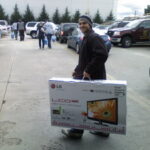HDTVs (High Definition Televions) can be a confusing item to shop for. Akin to how many people are lost when viewing a computer’s “RAM, Hard disk space, Processing speed, and video memory,” HDTVs have come with a set of specs all to their own that can once again baffle a first-time buyer. Learning what all of these things mean can be a dealbreaker between an “okay” television and a “wow!” television, and make that bang for your buck so much sweeter.
Display Types
First we’ll go over the various display types that currently exist in the world of HD. There is LCD, LED, Plasma, and Rear-projection.
- LCD televisions, or liquid crystal displays, are the same as what most people think of as computer monitors. The only thing separating the two is the TV tuner and built-in speakers. LCDs are usually the cheapest HDTV one can buy.
- LED is simply an LCD TV with LED lights (light emitting diode) to replace the standard CCFL (cold cathode fluorescent lamp). In less tech terms: this results in less heat, less energy used, and a brighter picture.
- Plasma is an older technology that used to be plagued with screen burn-ins and high energy consumption, although these have almost been eliminated the stigma still remains. Plasma will most often cost a pretty penny, but results in a sharper picture during fast moving scenes (think sports games or video games).
- Rear-projection TVs are exactly what they sound like. A projector shoots an image from the back to the front of the tv, These are often used for very large sets (50 to 65 inches and up, surpassing the size of any LCD set). This is also some of the oldest HD technology and is generally no longer available.
Screen Resolutions
Besides the fundamental type of television that you buy above, the most important aspect to look at in an HDTV is its resolution. The resolution is equivalent to how many lines of pixels are packed into a display, and the higher the amount of pixels, the better the image will look when viewing the appropriate content. Standard television is 480, while HD resolutions are 720 and 1080. These will be explained below.
- 480i and 480p are standard resolutions and are what have been on regular TVs for years. If your tv is not an HDTV, its resolution is equivalent to 480.
- 720p is the big step forward that you are looking for. This is what pushes television into the HD era, and is what most content you watch will be in. Video games as well as many high definition movies are natively displayed in 720p. If you’re on a budget, and are getting a tv that is 32″ or smaller, this is the resolution to aim for.
- 1080i deserves a little bit of special attention. Most 720p tvs will output 1080i as well as their native 720p resolution. This is because 1080i is what many high definition digital tv channels are broadcast at. If you buy HD programming from your cable or satellite company, it will probably be sent to you in 1080i. Any 1080p TV will display 1080i, as will most if not all 720p TVs.
- 1080p is considered the holy grail of HDTV screen resolutions. This is the highest HD currently available, and is used to get the best quality gaming and HD movie content possible. If you are planning on purchasing a tv that is larger than 37″, consider getting one that is 1080p.
As a sidenote, the i and p in the resolutions are different types of display technology. 480i means that the picture is “interlaced,” and 480p means that the image is “progressive.” Progressive resolution displays the full image at all times, while interlacing divides the frames into positives and negatives and then interchanges them. Progressive displays will result in a much cleaner picture.
Screen Size
Because of the higher resolution of HDTV, you can often get away with getting a television that is smaller than your old, boxy CRT television. HDTVs come in many sizes, ranging from 19″ screens to 27″, 32″, 37″, 42″, and 50″+ inch screen sizes. If you have had a 50″ CRT before, try a 42″ HDTV and see if it meets your needs. The words that appear on screen will be much easier to read than with a CRT television. As a rule, though, if you are going to be sitting more than 6 feet back, don’t go for anything smaller than a 32″. HDTVs that are 32″ are generally the most bought because they fill a niche between being too big and being too small.
Picture Quality
Things to look out for when looking for picture quality include contrast ratio and response time.
- Watch out for contrast ratio, as many TV manufacturers publish their tvs as having a dynamic contrast ratio. These numbers will range across insane numbers, and don’t really mean much on what type of contrast you will actually have. The only thing you can trust here is your vision.
- Response time has to do with a type of motion blur called “ghosting” on the screen; this affects video games as well as how quickly the screen translates actions from things such as button presses from video games is dependent on response time. The lower the number in miliseconds, the better (3ms is better than 5ms). Normally, plasma television will offer the lowest response times at 1ms, while LCDs offer anything from 3ms to 9ms.
- One other thing to watch out for: viewing angles. These are often not published, so if you get a chance to turn on a tv and test this out, do so. Unlike normal televisions, many screens on HDTVs will distort the color as you get out of its range. Walk to the far left/right and peer down at or up at the tv to see if the angles that the TV sends out a clear picture suit you well enough.
Sound
One issue many people have with HDTVs are that the sound is “tinny.” There’s really no way to tell if your TV will have “tinny” sound or not unless you are able to test the unit. If buying online, look at reviews to see if people complain about the built in sound. This can all be solved by hooking up your own sound system, of course.
Extra Features
Though not often a deal breaker, some TVs come with extra features such as internet connectivity so that you can download apps to your tv. Many HDTVs will have a DVI or VGA port to enable you to also use your tv as a monitor for your computer; look for this connection specification if you want it. Another common extra feature is 3D, to enable you to watch 3D movies and video games. Be sure the tv you are looking at has these if they are something you want.
Just remember, the most important things in buying an HDTV are what display type tv you buy, the resolution, and the size. Go for a good, well known brand and you’ll have little to worry about as far as picture quality is concerned. Happy buying!





